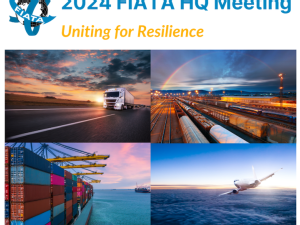The worldwide air cargo yield climbed to a level of USD 1.91 in February 2018, 1% above January 2018, and 23.1% higher than in February 2017.
Given the aftermath of Chinese New Year (CNY, Feb 16, 2018), worldwide year-over-year (YoY) volume growth in February (+4.4%) was way below the growth reported for January, resulting in a combined growth for the year's first two months of 6.95% YoY: a good start of the year by any standard (except by the standard of the extraordinary year 2017!). Yet, we still reserve our final judgment, as past experience has taught us that the post-CNY effects may last as long as three weeks, in other words into March... The origins Asia Pacific and Americas grew more than average in these two months (+9.3% and +8.4% YoY respectively). Europe, Central & South America and Africa were the best destinations (+9.5%, +8.5% and +8.4% YoY resp.).
Colombia, Ecuador and Kenya - in this order - are the world's flower growing powerhouses, together exporting about 3/4 of the world's airborne flowers. February, the month of Valentine's Day, brought the largest volume increase in flower exports from Ecuador (+11% YoY), followed by Kenya (+9.2%) and Colombia (+7.1%). But the latter realised the largest YoY USD-yield-increase (+14.6%). More than 85% of these exports went to the USA and Western Europe.
Worldwide yields rose by 19.9% in USD and by 3.8% in EUR in the first two months. The YoY oil price increase as well as the lower value of the USD, remain important elements in this comparison. But there is more to interpret these figures. Take the high-yielding markets from Asia Pacific on the one hand to Europe & North America on the other. Strong pre-CNY demand caused these large markets to grow much more in February than in January (!), thus boosting the average yield worldwide. Thus, the lower YoY volume growth in February was certainly not caused by the abovementioned large markets. The main reasons were (1) Asia Pacific as a destination showed a negative growth YoY, in particular to Hong Kong, Eastern China and Taiwan, and (2) the origin Europe, having shown a 12% YoY increase in January fell back to a paltry 0.5% YoY in February.
GSA-performance
WorldACD is one of the few organizations researching GSA-performance, which enables us to report on GSA-developments worldwide.
Around 23% of air cargo volume is sold via GSA's. This percentage has remained fairly stable over the past years. Not surprisingly, the percantage is much lower for the world's top-100 country-level O&D's (13%) than for the smaller markets (27%). We have data for 800 GSA's on record, together operating under more than 1000 different brand names.
In the world's latest Top-10, accounting for 35% of all GSA-business, we find ECS, ATC Aviation Services, Air Logistics, Kales, Aviation Solutions, FlyUS, Worldwide GSA, Nordic GSA, ScanPartners and Global GSA. They are mainly active in Europe and North America, where they take over 50% of all GSA-business. As the GSA-market is much more fragmented in Asia Pacific and the Middle East & South Asia, they take only about 14% resp. 19% in those areas, whilst they are virtually non-existent in Africa and Central & South America.
The largest group of GSA's remains WFC (World Freight Company), with brands like Air Logistics, ATC, Kales and Hermes Aviation. Number 2(ECS) has lately been most active in acquisition. YoY volume growth for the top-10 in 2017 varied from 1% to 54%. In the Top-100 country pairs, in 2017 GSA's produced yields for their principals on average 12% below the yields generated by airlines doing their own sales. In 2016, the gap was 10%.











